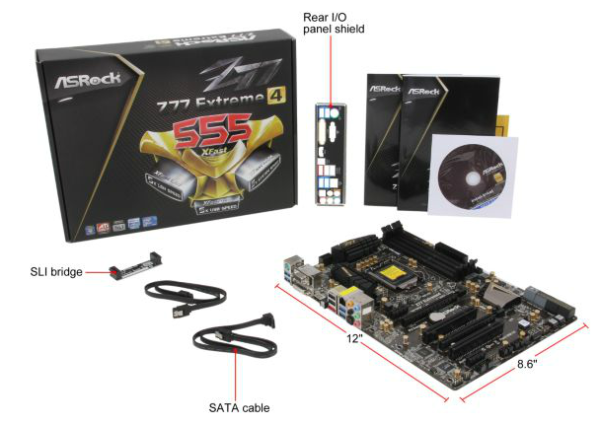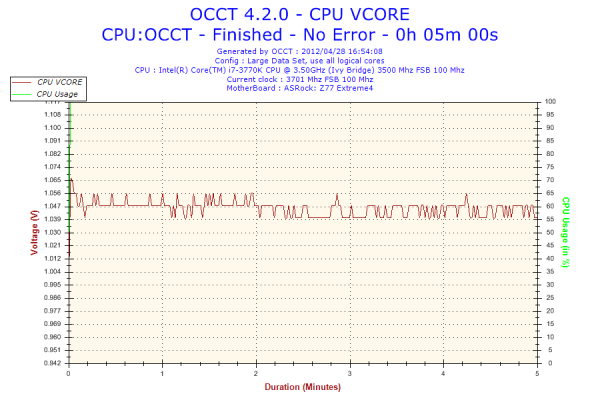Intel Z77 Motherboard Review with Ivy Bridge - ASRock, ASUS, Gigabyte, and MSI
by Ian Cutress on May 7, 2012 7:40 PM EST- Posted in
- Motherboards
- MSI
- Gigabyte
- ASRock
- Asus
- Ivy Bridge
- Z77
ASRock Z77 Extreme4 - In The Box
Driver CD
User Manual
IO Shield
2 locking SATA cables
3-slot SLI bridge
Uncharacteristically from ASRock, we do not have a lot to shout about regarding the contents of the box. Previously with the P67 products we had a USB 3.0 bracket, but this time we are limited to just a pair of SATA cables. This is unfortunate, but perhaps was required to hit a price point.
Voltage Readings
Using OCCT we monitor the voltage change of the motherboard under load. This represents the direct correlation between the Load Line Calibration and how the processor/motherboard deals with voltage requests while under load. This is not to be confused with the quality of power delivery, but more an indication of how aggressive the default LLC settings are on a motherboard.
The CPU voltage at load for the ASRock board seems to vary more than the other boards in this review, which may be a result of the price difference. Nevertheless, this is not a series of massive jumps to be concerned over.
Overclocking
Note: Ivy Bridge does not overclock like Sandy Bridge. For a detailed report on the effect of voltage on Ivy Bridge (and thus temperatures and power draw), please read Undervolting and Overclocking on Ivy Bridge.
As the first explanation of overclocking results on a platform, I would highly suggest you read my article on overclocking performance on Ivy Bridge. As the successor to Sandy Bridge, people may expect similar to Sandy Bridge. However, there are a number of key differences, especially in terms of heat generation and applied voltages.
Auto Overclocking: ASRock comes with several automatic overclocking features, however these are all in the BIOS – ‘Enhanced Turbo 30’ and ‘Optimized CPU Setting’. Enhanced Turbo 30 initially calls upon preloaded settings – 4.7 GHz on the CPU, 1600 MHz on the iGPU, +0.085 volt offset on the CPU and CPU load line calibration (LLC) set at ‘Level 1’. This setting did not do anything to the memory, and made the machine run rather hot – 92ºC during OCCT causing it to stop, and 97ºC during PovRay. Both of these temperatures were on the test bed outside a case, so I would not recommend them inside a case!
The Optimized CPU Settings offers CPU speeds in 200 MHz increments. When selected, it adjusts the CPU multiplier but leaves all else on automatic.
- At the 4.4 GHz setting, this gave 1.112 volts on load, 72ºC during PovRay and 70ºC for Blender.
- At the 4.6 GHz setting, this gave 1.192 volts on load, 85ºC during PovRay and 86ºC for OCCT.
- At the 4.8 GHz setting, this gave 1.240 volts constant at LLC Level 1. This caused the blue screen of death on boot.
Manual Overclocking: Given the overview of overclocking on Ivy Bridge, choosing your maximum voltage to aim for a speed is critical. The best combination I achieved on the ASRock Z77 Extreme4 was 4.7 GHz at 1.175 volts, using LLC Level 1. This gave 86ºC during both PovRay and OCCT, which is essentially near the limit as to what I would suggest on Ivy Bridge.












117 Comments
View All Comments
Jase89 - Sunday, May 19, 2013 - link
Having RAID Option ROM Supported in UEFI as well (people using RAID) is a very good thing ASRock have done with their Z77 series, wonder when Gigabyte will add this feature, http://www.youtube.com/watch?v=Y1TbdVtAE9cgramboh - Tuesday, May 8, 2012 - link
Just wanted to add that my new P8Z77-V Pro POSTS significantly faster than what Ian experienced in this review, probably due to my configuration:Intel SATA: AHCI
ASmedia USB3: on
ASmedia SATA controller: off
Wifi: off
Onboard sound: off
My total time from splash screen to Windows 7 Pro x64 login is 15 seconds on a Mushkin Chronos Deluxe 240GB. The post is about 6 seconds (hand timing these). It's unfortunately the other controllers add ~14 seconds of POST time.
IanCutress - Tuesday, May 8, 2012 - link
Hi Gramboh,Disabling ASMedia SATA, Wifi and Sound would obviously decrease POST time by quite a bit! As I doubt the majority of non-enthusiast buyers would go into the BIOS and disable what they don't need, I kept the start up sequence the same as default to reflect this.
Ian
DanNeely - Tuesday, May 8, 2012 - link
A large number of your readers are enthusiasts. Giving both sets of numbers would be beneficial for us. A per onboard device breakdown of boot time would be nice; but probably too much work to be justified.IanCutress - Tuesday, May 8, 2012 - link
I've added 'POST Quick' to my internal database of testing, with the aim to turn off all I can to observe POST times. Will be applied from the next review onwards, perhaps retroactively if I get time.Ian
AlexIsAlex - Wednesday, May 9, 2012 - link
Awesome, thank you so much!Perhaps the manufacturers will pay attention to this too :-)
Paapaa125 - Wednesday, May 9, 2012 - link
I think most Anandtech readers DO go to BIOS to set things up. I think it is crucial to know if the differences in performance (boot time, benchmarks, power consumption etc) can be minimized just by changing BIOS settings. That would make it a lot easier to buy a new board.I have seen reports that some boards don't follow the Intel specs regarding Turbo Boost settings and utilize higher frequency with all cores utilized. This skews the performance results greatly. Those following the specs get worse results - yet they could be configured for exact same performance.
dananski - Tuesday, May 8, 2012 - link
Makes me really glad to have ordered the ASRock, though I wonder how it would be affected by having RAID enabled? My GA-P35C-DS3R takes about a minute to get through POST and RAID screens.I am also confused why even the quick one is taking so long. My laptops take less than 5 secs to POST :/
EnzoFX - Monday, May 7, 2012 - link
ATX just seems like it's for bragging rights, and not even directly so, simply because you'll be able to say you have so many things connected, maybe you even have tri or quad SLI, all in a huge case. Can we get some coverage of mATX boards?On another note, something that drives me nuts is the AHCI driver loading at POST. Last time I checked I couldn't find a straight answer, does this loading stage still happen in ivy bridge? Of course you don't have to use AHCI, but it really should be standard and enabled by default. At least for anyone spending this much on a motherboard.
EnzoFX - Monday, May 7, 2012 - link
"Conclusion – Gigabyte MSI Z77A-GD65"One more rant lol. Is having all 4 video outputs really a feature? Is this not targeted at people who will be using their own graphics card? In which case they only serve to use up space that could be used towards USB ports or something else that's almost as useful. Remember before P55, 10 usb ports were starting to be the average on a feature filled board, now we have to settle for 6-8. Unless you want to spend top dollar for more.